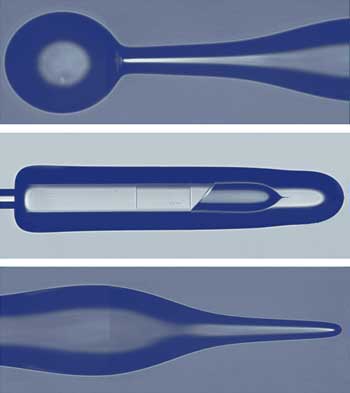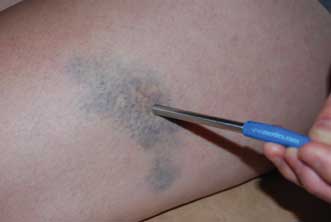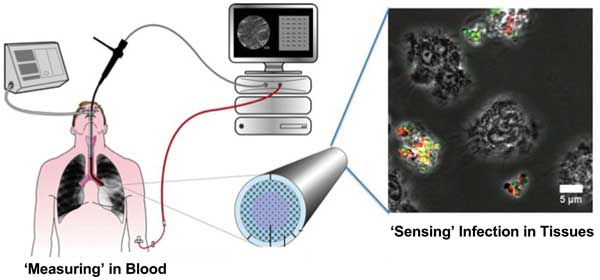Companies report continued growth in the biomedical market.
As diagnostic and treatment technologies evolve and increasingly turn to light, medical device manufacturers increasingly turn to fiber optic components and systems to deliver that light to tissues and organs. They might as well – the market is not only strong but also expanding, according to industry leaders.
“The market has been very robust,” said Rob Morris, marketing operations manager at Ocean Optics in Dunedin, Fla., which provides mini fiber optic spectrometers as well as fiber optical chemical sensors for use in R&D, point-of-care analysis and medical diagnostics. “Although we don’t sell medical devices, we sell optoelectronic sensing components to customers who integrate those components into their own devices.
“This OEM business has been successful, in large part because the inherent properties of fiber optic technology make it attractive for noninvasive analysis.”
Versatility is one of those inherent properties that give fiber optics a huge advantage.
Just ask CeramOptec in East Longmeadow, Mass., which makes specialty multimode fibers, assemblies and bundles, including custom design for a wide variety of medical applications. “Because we produce our own preforms and fibers, we can vary the fiber specifications – core, core:clad ratio, numerical aperture – to meet the specific needs of the application,” said Kevin Bakhshpour, vice president of sales and marketing. “We produce fiber assemblies and bundles to the designers’ requirements. We have almost no limits as to number of fibers, end design, length.”
That’s useful for medical device development. As new and better imaging methods are born, for example, photonics-based techniques are moving in on the market. Traditional x-ray imaging is being replaced by CMOS-based detectors using fiber optic faceplates, said Scott Farland, director of business development at Incom Inc. in Charlton, Mass.
Farland added that the faceplates help the CMOS detectors produce better images, lower radiation exposure on the sensors and bring down operating costs. “Sales of these systems [have] been increasingly strong in the past 18 months, with a very strong forecast over the next several years as market adaptation continues to grow.” He predicted that all current digital radiography applications will quickly move to the CMOS-based platform.
And in the future, that market growth can only continue, said Jean-Michel Pelaprat, CEO of Vytran in Morganville, N.J., which produces capital equipment for development and high-volume production of fiber terminations and fiber assemblies – probes, deliveries, lenses and image guides – for imaging applications such as OCT as well as fiber deliveries for therapeutic applications. “While it is in infancy today, the combination of engineering creativity with the manufacturing techniques that are now available make it poised to grow.”

Fiber optics can take various forms for a range of biomedical applications. Top to bottom: a ball lens, an OCT probe and a fiber probe. Courtesy of Vytran.
Today’s thriving applications include OCT and other applications employing lasers, due in part to the desire for less-invasive delivery methods and also sources that are less destructive to samples.
“Laser-based applications such as Raman certainly have shown a surge of interest,” Morris said. “Raman is a very useful technique for chemical analysis, especially because of the strong specificity of the Raman signature of many samples.
“In addition, Raman analysis is non-destructive, requires very limited sample preparation, and allows for sample volumes in the microliter range. For applications where C-OH structural information is important, for example, 532-nm Raman is typical. Such measurements are common in biological and pharmaceutical sample analysis.”
And these are fast-moving fields, especially in imaging and diagnostics. “The advances come so quickly, it can be hard to keep up,” Morris said. “We’ve had customers involved in all sorts of interesting diagnostics research, from point-of-care blood monitoring to noninvasive cancer detection.
“One of the more interesting applications of recent vintage has to do with a sensor that a person could use to test if the alcoholic drink they ordered at the bar or restaurant had been doped with a narcotic or other harmful substance.”
But biophotonics companies are not content to sit back and see what happens: They’re also out on the front lines, working with researchers and clinicians to develop new tools and techniques. “Incom is currently collaborating with several universities and national labs to develop next-generation PET detectors by combining microchannel plate and traditional photomultiplier tube technology,” Farland noted.
Imaging quality and accuracy are always improving, Pelaprat said. “The new devices will soon percolate into manufacturing,” he added.
These companies are working to develop “the next big thing,” but the definition of that term varies from one company to the next.
“As with most technology, the desire to make systems and devices that are smaller, faster and more economical is a significant driver,” Morris said. “In spectroscopy, there is growing interest in Raman, NIR and other techniques, especially as they become more accessible, as a complement to – or, in some cases, replacement for – more involved methods of analysis.”

This image was taken as part of a study of contusions in suspected victims of child abuse. Spectroscopy can be used to test the age of the bruise and is a more reliable indicator than visual inspection. Courtesy of Ocean Optics.
Incom is developing a capillary-based x-ray antiscatter grid that Farland said could be a highly disruptive technology in digital radiography. He also said that full-chest-area CMOS-based x-ray detectors drove the development of the largest-ever fiber optic faceplates: up to 17 x 17 in.
But there are challenges, even in a growing field. The speed of technological development means that, for companies, continuing to innovate and improve upon technologies can bump heads with the need to simultaneously meet increased volume demands, Farland said.
And there’s always the government: Getting approval for new medical devices tends to be very costly, Bakhshpour pointed out.
Morris agreed. “Regulatory hurdles are certainly one challenge, especially as the regulators struggle to keep up with the pace of development,” he said. “Another challenge is being able to keep instrument production costs reasonable even as the level of device sophistication increases.”
Still, companies in the biophotonics arena generally have an overwhelmingly positive outlook. “The breadth of inquiries for products for medical applications seems to expand each year,” Bakhshpour said. “Fields such as general surgery, urology [and] ophthalmology continue to expand their product lines. As well as diode laser delivery systems. Life sciences and spectroscopy continue to grow and advance.”
“The market is only going to get bigger,” Morris added. “New technologies will inspire applications we can’t even imagine right now, and new diagnostic challenges will drive the market to continue to innovate. Also, I believe you’ll see much more specificity in diagnostics sensing as fiber optic systems evolve.”
All of which will mean more business. “We believe that the manufacturing cost of these medical devices is dramatically reduced as a result of high-volume manufacturing techniques and, thus, manufacturing volumes will go from tens of thousands to millions,” Pelaprat said.
UK Health Care Invests in Fiber Optics
The development of fiber optic sensors that monitor the condition of intensive care patients is among the projects that will benefit from a £32 million (about $49 million) investment by the Engineering and Physical Sciences Research Council (EPSRC). The project is one of three involving smartphones, probes and sensors that aim to transform health care, the council said.
The EPSRC is investing the money in establishing three new health care interdisciplinary research collaborations (IRCs); an additional £9 million (about $14 million) is being contributed by universities and project partners.
“Today’s health care challenges are many and complex; designing and integrating technologies that will help clinicians to diagnose and monitor patients is where the cross-disciplinary research we are funding at these IRCs can play a vital role,” said EPSRC CEO Dave Delpy.

The Multiplexed ‘Touch and Tell’ Optical Molecular Sensing and Imaging project will create a fiber optic device to detect disease and monitor critically ill patients without the need for blood sampling. Courtesy of the University of Edinburgh.
The Multiplexed “Touch and Tell” Optical Molecular Sensing and Imaging project will create a fiber optic device to detect potentially fatal lung conditions in intensive care patients, and to continuously monitor the blood in critically ill adults and babies without the need for blood sampling. It will be led by professor Mark Bradley of the University of Edinburgh, working with Heriot-Watt University and the University of Bath as well as project partners ST Microelectronics, Carestream Health, Edinburgh Biosciences and the UK Astronomy Technology Centre.
Under a £9 million EPSRC grant, the £11 million (about $17 million) project brings an interdisciplinary team together to design, make and test a small fiber optic probe that can be used at the patient’s bedside, inserted into his or her lung, blood vessels or other body parts, such as digestive, urinary or reproductive tracts.
The probe will contain a variety of special optical fibers, some of which allow clinicians to “view” inside the lung, while others will be modified with sensors that can measure important parameters, such as oxygen concentration and acidity, in both blood and lungs in real time. The fiber will also deliver “smart reagents” that detect specific bacteria and viruses and sense other processes that can cause lung damage.
Initially, the research will focus on patients in intensive care, where potentially fatal lung complications are a common problem with ventilated patients, and on critically ill babies, who often need to have blood samples taken to test oxygen and acid levels.
The two other projects are a smartphone test and tracking systems for infectious diseases, and in-home sensors that can immediately relay patient information to doctors.
For more information, visit www.epsrc.ac.uk.